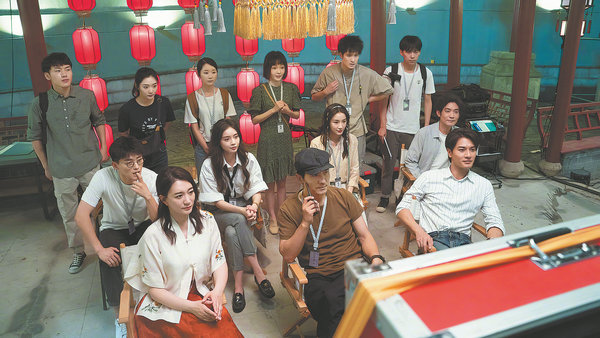
Tales of History Turn into Stories with a Modern Twist

Back in 2014, a chicken-pattern porcelain cup from the Ming Dynasty (1368-1644) was sold for a whopping HK$ 281.24 million ($36 million) at an auction in Hong Kong, making it one of the most expensive ceramic vessels of its time and attracting global media attention.
Recently, this precious treasure "appeared" in a popular online series, with its romantic story being retold and reimagined. The cup was commissioned by Zhu Jianshen, the eighth emperor of the Ming Dynasty who experienced a traumatic childhood.
At the age of 5, he was deposed from his position as crown prince and spent five years living in fear of being murdered until his father reclaimed power and restored him as heir to the throne. Throughout the dark period, Zhu found comfort in a royal maid named Wan Zhen'er, who eventually became his beloved wife despite being 17 years older than him. The cup, gifted to Wan by Zhu, was a symbol of their connection.
Featured as a play-within-a-play, the unusual palace love story has been deftly woven into a cultural program, which serves as the backbone to lead the plotline development of Hi Producer, a 35-episode drama currently available on streaming sites iQiyi and Tencent Video.
Filmed between April 19 and Aug 1, 2021, this online series was primarily shot in Suzhou, Jiangsu province, and Hengdian town in Jinhua, Zhejiang province. It is also the first series to be shot at the Suzhou Museum.
The drama follows Yu Zaizao, a young and talented director who joins a production company with plans to produce a program showcasing some of the country's most influential cultural legacies, ranging from Peking Opera to jade sculpture and the filigree inlay technique.
With the help of Tao Tang, a suave and versatile antiquarian, Yu manages to invite a group of prestigious intangible cultural heritage inheritors, and creatively makes the program a hybrid of museum tours, modern heritage revival and mini-costume dramas which bring to life the historical figures behind these handicrafts or artistic practices.
By adopting a fresh perspective to display a total of 16 intangible cultural heritages inscribed on different-leveled lists, from UNESCO to national and provincial levels, the drama opened to a score of 7.6 out of 10 on the review aggregator Douban upon its release late last month.
Director Gao Han tells China Daily that he was excited to read the script for the first time and decided to use an "immersive" approach to make traditional cultures "come alive".
Interestingly, he has developed a method that easily captivates modern youngsters, which he describes as being inspired by how today's young people understand and learn traditional cultures in their own way.
The effort to make old items resonate with young people is evident from the first episode, which features Yu, a woman in her 20s, assigned to shoot footage of a veteran inheritor of the filigree inlay technique, a skill that dates back to the Spring and Autumn Period (770-476 BC).
Reaching its pinnacle during the Ming Dynasty and favored by royal families, this handicraft involves weaving and twisting thin strips of gold or silver into beautiful patterns and decorating precious stones in metal frames for use in accessories or adornments.
However, Yu feels disappointed when she discovers that the inheritor, who has 37 years of experience, excessively interferes in the filming process, and only allows her cameramen to shoot regular procedures that have been featured in many similar shows.
Unwilling to record stereotypical footage that could result in her being fired, the quick-minded young director comes up with a fresh idea. She plays a palace lady, showcasing the makeup procedure using a hairpin made with the filigree inlay technique and a replica set of the combs used by Empress Dowager Cixi, the most powerful woman during the late Qing Dynasty (1644-1911).
The video, which resembles that of a beauty blogger time-traveling back to China's last imperial dynasty, helps the program gain popularity among young viewers.

In addition to re-enacting ancient stories related to these techniques, the female protagonist also takes great care in exploring the unique stories behind each inheritor, making the program more emotionally engaging.
"I would like to use a line from Yu, who says: 'What audiences truly care about is people, and the connection between cultural relics and people to convey the core theme of the TV series.' I believe it will be a fresh experience for viewers to see how the stories of the craftsmen are intertwined with the creation of a cultural program," says Gao.
Among these stories is that of a dancer who reconstructs classical dances from relics like the Dunhuang murals, and who reconciles with a friend whom she had previously misunderstood.
Another story follows a renowned pastry chef who is dedicated to restoring the recipes of refreshments that were served on Suzhou ship voyages from centuries ago. She reunites with her estranged son after leaving him in the care of his grandparents for many years.
Another highlight of the online series is that each tale concludes with a short clip featuring an expert who introduces additional knowledge about the craft. As an example, Du Jianyi, a seasoned inheritor of the filigree inlay technique with around 50 years of experience, describes how the renowned Golden Wing Crown of Ming Emperor Wanli (1563-1620) was created using 518 golden wires as thin as 0.2 millimeters.
"I hope to showcase not only a simple display of intangible cultural heritage skills, but also the historical allusions, production techniques, cultural connotations, emotional colors and the culture itself behind each intangible cultural heritage," says Gao.